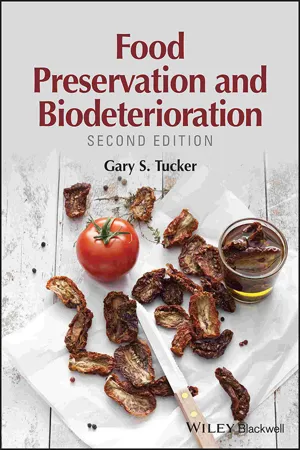
- English
- ePUB (mobile friendly)
- Available on iOS & Android
Food Preservation and Biodeterioration
About This Book
Food Preservation and Biodeterioration
Food Preservation and Biodeterioration
Biodeterioration is the breakdown of food by agents of microbiological origin, either directly or indirectly from products of their metabolism. Preservation on the other hand is the process by which food materials are maintained in their original condition or as close to this as possible.
This second edition of Food Preservation and Biodeterioration is fully updated and reorganised throughout. It discusses how the agents of food biodeterioration operate and how the commercial methods available to counteract these agents are applied to produce safe and wholesome foods. With this book, readers will discover traditional methods and major advances in preservation technology. Both microbiological and chemical pathways are analysed.
This topic being important to all producers of food, the readership spans food scientists across the industry and academia, particularly those involved with safety and quality.
Frequently asked questions
Information
1
Control of Biodeteriorationin Food
1.1 OVERVIEW
1.2 A SUMMARY OF THE DIFFERENT KINDS OF BIODETERIORATION
1.2.1 Chemical biodeterioration
- Biochemical assimilatory biodeterioration – the organism uses the material as food or an energy source. Growth of mould on bread is an example of this type of biodeterioration.
- Biochemical dissimilatory biodeterioration – the chemical change in the food is as a result of waste products from the organisms in question. Examples of this are pH changes in food that arise from acids generated from the metabolic action of microorganisms such as bacteria, yeast and mould.
| Affected material | Example | Type of biodeterioration |
| Stone, marble, concrete | Deterioration of stone monuments | Chemical assimilatory: where calcium and other minerals are used as a food source Chemical dissimilatory: where acid by-products dissolve the surfaces Mechanical: where root damage can undermine and weaken structures Fouling: where biofilms can affect the aesthetics of the structure |
| Wood | Rotting of wooden floorboards and timber structures | Chemical assimilatory: where the cellulose and lignin in the wood are used as food by fungi and other organisms Dissimilatory: where acid and other by-products result in breakdown of the structure |
| Leather | Loss of strength and structure of leather objects | Chemical assimilatory: by proteolytic bacteria, which break down the proteins |
| Paper | Degradation of books | Chemical assimilatory: most commonly by fungi |
| Paint | Water-based paints | Chemical assimilatory: by bacteria and fungi, results in thinning of the paint and production of off odours |
| Museum artefacts | Discoloration and degradation of valuable relics | Chemical assimilatory and chemical dissimilatory: by bacteria and mould, resulting in weakening of structures and discol... |
Table of contents
- Cover
- Title Page
- Table of Contents
- Preface
- 1 Control of Biodeteriorationin Food
- 2 Principles of HACCP: The Importance of HACCP Systems in Food Manufacturing
- 3 Thermal Processing
- 4 Chilling
- 5 Freezing
- 6 Drying
- 7 Modified Atmosphere Packaging
- 8 Preservatives
- 9 Hurdle Techniques
- 10 Novel Commercial Preservation Methods
- Index
- End User License Agreement